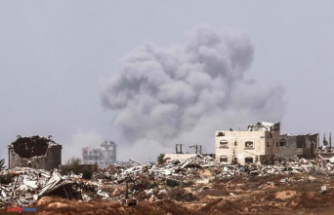Dense smoke lies over the Elbe valley. Helicopters cannot ascend in the Saxon Switzerland National Park on Thursday morning. The view is too bad. Help from the air is urgently needed: the fires in Saxony on the border with the Czech Republic continue to spread.
Not good news for emergency services who have been fighting the flames since Monday. The situation on the Czech side is no better. In contrast, there is a slight relaxation in Brandenburg. But even here the danger is far from over.
Wind shifting from the direction of the Czech Republic exacerbated the situation in the Saxon Switzerland National Park during the course of the day. The fight against the fire in the afternoon was aimed at preventing further spread of flames from the neighboring country, the Saxon Switzerland-Eastern Ore Mountains district office announced. "The emergency services are doing their utmost to further contain the fire." The wind at least ensures that the fire-fighting helicopters can take off.
Around 340 emergency services are on site at noon. Dozens of workers from various aid organizations take care of the logistics and supplies. "The situation is tense," says the spokesman for the affected district, Thomas Kunz. So far, however, no towns or individual buildings have been evacuated, and there is currently no danger to the population. According to Kunz, however, there are corresponding concepts that could be implemented quickly.
The danger of further forest fires is also very high in the south of Brandenburg. The fire flared up again south of the Kölsa-Rehfeld deployment area due to hot embers with temperatures between 40 and 180 degrees, the Elbe-Elster district announced. In the morning it is said that the fire is under control. Around 300 emergency services from several parts of the country fought against the flames.
A tank engineer cuts aisles in the forest
A Bundeswehr helicopter flies continuously from an acute fire area to nearby Kiebitzsee in Falkenberg to extinguish the flames with a water tank that can hold up to 5,000 liters. The lake is closed to swimmers. On the ground, a Bundeswehr armored personnel carrier provides support to create paths for the fire-fighting crews through the impassable terrain and to cut aisles so that the flames can no longer spread so quickly. A second tank is scheduled to arrive on Friday.
In the Saxon area of operations, the full extent becomes clear from the air. Plumes of smoke stretch for miles into the sky. Other helicopters keep dropping water to fight the flames in the impassable terrain. Eight fire-fighting helicopters, three more machines for reconnaissance flights and two water cannons from the state police are helping. The Czech Republic lets more water into the river from dams for extinguishing. According to the district, around 250 hectares of forest are on fire in the afternoon.
The fire broke out in the Bohemian Switzerland National Park in the Czech Republic over the weekend and spread to the Saxon Switzerland National Park on Monday. According to the fire brigade, around 1,000 hectares have already burned down on the Czech side. "We stick to our positions, we didn't have to retreat anywhere," says a fire department spokesman for the CTK agency. Nearly 500 firefighters are on duty battling the blazes in one of the largest wildfires in the country's history.
Disaster alert in Bad Schandau
The emergency services in the region are still unable to cope with the situation in southern Brandenburg alone. For this reason, emergency services from other parts of the state were requested, according to the administrative staff. The area on which the forest fire is still active should be measured during Thursday. The forest fire broke out on Monday and initially spread to around 800 hectares within a very short time.
In Bad Schandau in Saxon Switzerland, a disaster alarm has been in effect since Tuesday. Tourists should avoid the area. The forests in the district of Saxon Switzerland-East Ore Mountains may not be entered until further notice. For Saxony's Environment Minister, the forest fires are the consequences of climate change. "We see a whole new reality when it comes to forest fire risks," says Wolfram Günther (Greens) in Bad Schandau.
According to experts, it is difficult to prove a direct connection between climate change and individual forest fires. One thing is certain: due to climate change, there will be more hot days. Heat alone does not trigger forest fires. But high temperatures, drought, low humidity and wind can increase the risk of wildfires.
waiting for rain
Interior Minister Armin Schuster (CDU) praises the forces who fought "beyond the exhaustion limit". At the same time, he promises help: According to Schuster, the first of the three firefighting helicopters ordered will be ready in Saxony next year. Schuster assumes that it will be a long time before the fire is completely extinguished. "I also fear that the rain forecast for Saturday will not be enough."
Rainfall is expected for Friday evening. "But these are not extensive. There are localized showers, which cannot be precisely predicted for a region," says Florian Engelmann from the German Weather Service (DWD) in Leipzig.
In Brandenburg, the year 2022 with currently almost 400 fires could surpass the devastating forest fire season of 2018 if there is not enough precipitation. This is the assessment of the state's deputy forest fire protection officer. "As of today, we have 100 more forest fires than at this time in 2018," said Philipp Haase on Thursday of the German Press Agency. Four years ago, in the drought summer, around 1,680 hectares of forest burned in 512 fires. This corresponds to an area of more than 2350 football pitches.












